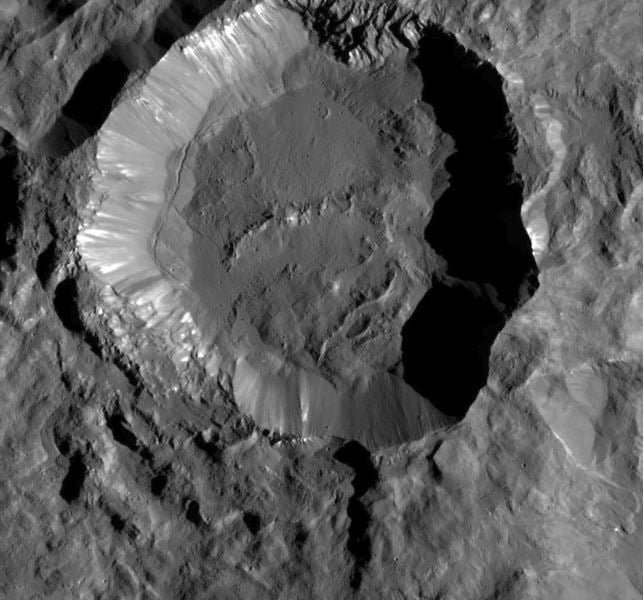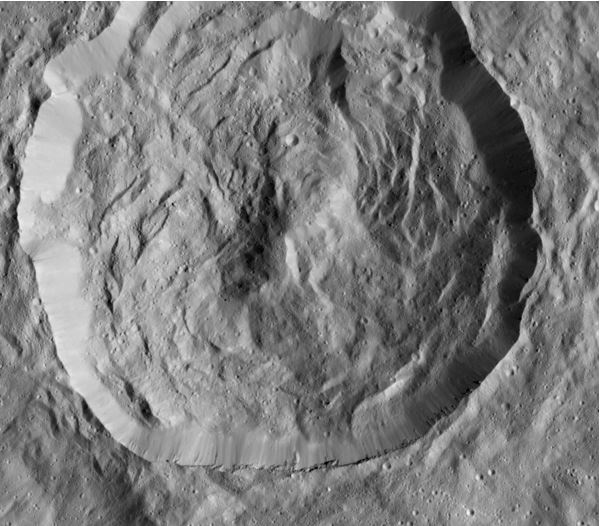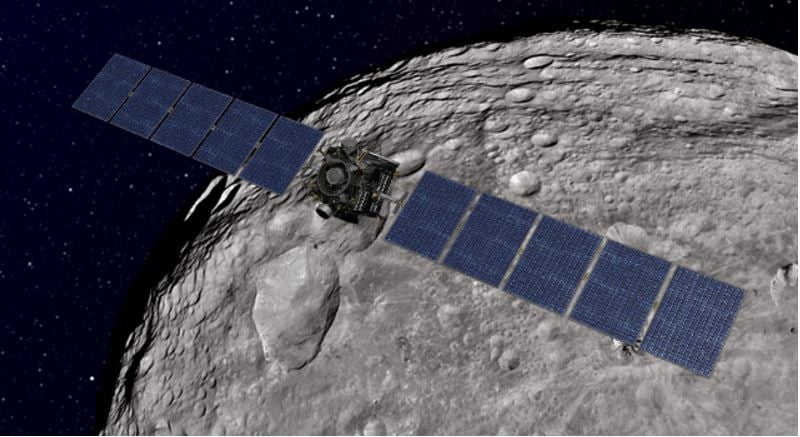Beautiful pictures of the dwarf planet Ceres, which piqued the interest of astronomers and planetary scientists throughout 2015, have been released by NASA. The images were sent from NASA’s Dawn spacecraft, which recently came to its lowest-ever altitude at Ceres.
According to NASA, the images were captured when Dawn was just 240 miles (385 km) from Ceres, between 19th and 23rd December, 2015.
Kupalo Crater, one of Ceres’ youngest craters, shows off several fascinating features at the high image resolution of 120 feet (35 m) per pixel.
 Image of the Kupalo Crater, one of the youngest craters on Ceres, taken from NASA’s Dawn spacecraft. The crater has bright material exposed on its rim and walls, which could be salts. Its flat floor likely formed from impact melt and debris. (Image: nasa.gov)
Image of the Kupalo Crater, one of the youngest craters on Ceres, taken from NASA’s Dawn spacecraft. The crater has bright material exposed on its rim and walls, which could be salts. Its flat floor likely formed from impact melt and debris. (Image: nasa.gov)
Bright material is exposed on the crater’s rim, which NASA scientists believe could be salt. Its flat floor was probably formed from impact melt and debris.
Are bright spots salt deposits?
Researchers will be examining this material carefully to see if they can determine whether it is related to the ‘bright spots’ of Occator Crater, which got everybody excited about something super exotic possibly existing on the dwarf planet.
Kupalo, which is 16 miles (26 km) across and is located at southern mid-latitudes, is named after the traditional Slavic mythological god of harvest and vegetation.
Paul Schenk, a member of the Dawn science team at the Lunar and Planetary Institute in Houston, Texas, said:
“This crater and its recently-formed deposits will be a prime target of study for the team as Dawn continues to explore Ceres in its final mapping phase.”
Fractures on crater floor similar to those on the Moon
Dawn’s close proximity to Ceres’ surface also captured the dense network of fractures of the Dantu Crater. This 78-mile (126-km) wide crater has similar fractures to those on Tycho, one of our Moon’s youngest large craters.
 In this image you can see the fractured floor of Dantu Crater on Ceres. (Image: jpl.nasa.gov)
In this image you can see the fractured floor of Dantu Crater on Ceres. (Image: jpl.nasa.gov)
This cracking was probably the result of the cooling of impact melt, or perhaps when the crater floor was uplifted after the formation of the crater.
West of Dantu there is a 20-mile (32-km) wide crater covered in steep slopes (scarps) and ridges. These features probably formed when the crater partly collapsed while it was being formed.
The scarp’s curved lines resemble those on the floor of Rheasilvia, the huge impact crater on protoplanet Vesta, which Dawn orbited in 2011 and 2012.
Scientists will soon know which minerals are present
Dawn’s other instruments also started studying Ceres intensively in the middle of December. The visible and infrared mapping spectrometer is examining how several wavelengths of light are reflected by the dwarf planet, which will help identify which minerals are present on its surface.
 This 20-mile wide crater is located just west of Dantu. It is covered in ridges and scarps (steep slopes). (Image: jpl.nada.gov)
This 20-mile wide crater is located just west of Dantu. It is covered in ridges and scarps (steep slopes). (Image: jpl.nada.gov)
NASA scientists are also being kept busy with data sent from GRaND, Dawn’s gamma ray and neutron detector. Data from GRaND helps scientists determine how common certain elements are on the surface of Ceres, along with details of its composition, which hold important clues about how it evolved.
Dawn, which was launched by NASA in September 2007, will remain at its current altitude indefinitely. Its mission ends on June 30th, 2016. After that date, it will continue orbiting Ceres at low altitude.
 What do you think this bright, white spot is on Ceres. Go to this webpage and click on an option.
What do you think this bright, white spot is on Ceres. Go to this webpage and click on an option.
Chris Russell, principal investigator for the Dawn mission, based at the University of California, Los Angeles, said:
“When we set sail for Ceres upon completing our Vesta exploration, we expected to be surprised by what we found on our next stop. Ceres did not disappoint. Everywhere we look in these new low- altitude observations, we see amazing landforms that speak to the unique character of this most amazing world.”
Dawn is the first probe to visit a dwarf planet, and the first mission outside the Earth-Moon system to orbit two different solar system targets. It orbited Vesta for 14 months in 2011-2012, and then arrived at Ceres on 6th March, 2015.
 An artist’s concept of NASA’s Dawn spacecraft orbiting the giant asteroid Vesta. (Image: jpl.nasa.gov. Credit: NASA/JPL-Caltech)
An artist’s concept of NASA’s Dawn spacecraft orbiting the giant asteroid Vesta. (Image: jpl.nasa.gov. Credit: NASA/JPL-Caltech)
The Dawn mission is managed by NASA’s Jet Propulsion Laboratory, with spacecraft components contributed by European partners from Germany, Italy and the Netherlands. It is the first NASA space probe to use ion propulsion, which allowed it to enter and leave the orbits of several celestial bodies.
Previous missions to multiple bodies using conventional drives were restricted to flybys.
NASA’s Jet Propulsion Laboratory wrote the following regarding the Dawn Mission:
“Dawn’s goal is to characterize the conditions and processes of its earliest history by investigating in detail two of the largest protoplanets remaining intact since their formation. Ceres and Vesta reside in the main asteroid belt, the extensive region between Mars and Jupiter, along with many other smaller bodies.”
“Each followed a very different evolutionary path, constrained by the diversity of processes that operated during the first few million years of solar system evolution. When Dawn visits Ceres and Vesta, the spacecraft steps us back in solar system time.”
Video – Pictures of Ceres show craters & bright spots in sharp detail
